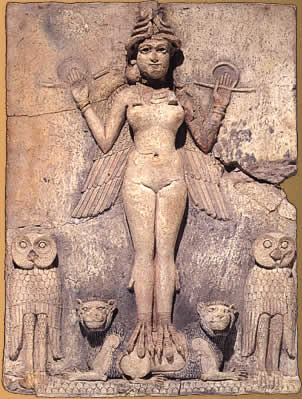
The lamia or succubi archetype is almost universal. Lilith is one of those characters who provides ample wings to our collective imagination. But we should make a difference among her roots, her formation and her consolidation, since here different cultures were involved.
To begin with, we'll analyze her sumerian origin according to local beliefs.
In those times people thought that the souls of men and women who died early were damned to harass the living until at last they were given relief through a suitable ritual. These beliefs are mentioned in assyrian spells.
The ghost of a woman who died when giving birth is another belief which was shared by a few cultures. In Arabia it was believed that owls who hooted at night were really weeping women who were searching for their lost children, transformed into lonely birds. For the malayan people, if a woman dies while giving birth she turns into a flying demon, langsuyar, a female familiar. It is thought that the original langsuyar is some kind of night owl, like the Lilith from the rabinic tradition. For the arabs in Palestine, the royal owl from the egyptians is a bewitched woman who negatively influences childbirths whenever she can. In an ancient arab tradition, Laila transforms into an owl when she flies from the grave of her lover.
In the Banks Islands in Melanesia, if a woman dies giving birth and her child survives, her spirit cannot depart for the land of ghosts. In the Pelew Islands, a woman spirit cries, 'give me the child!'. The same ghost appears in India.
Lilitu (female demon, wind spirit) and ardat lili (in acadian) were two types of female demons. Ardat lili has the connotation of a marriageable woman and seems to have been related with humans much more closely than lilitu, taking over the role of the hebrew Lilith (ethimologically equivalent to lilitu). This succubus becomes the ghost-wife of men due to their desire to find a partner.
Her male counterpart is idlu lili. Idlu is the adult male with his strength fully developed. The lilu would be the male counterpart of lilitu.
Both men and women could get together with a Jinn and other invisible powers.
Rabinic literature tells about the misdeeds of Lilith, who brought hundreds of demons to our world. Rabbis believed that males could have children with a demon. In Pirke, the real father of Cain wasn't Adam, but one of these demons. In the book of Enoch it is said that evil spirits are sons of women coupled with the 'holy guardians'. Justino Mártir affirms that demons are the descent of angels who had intercourse with women. In the slavic Enoch, Satan is Eva's lover. And Azazel is known as a seducer of both men and women.
The first appearances of Lilith come from the sumerian culture in the third millenium before Christ. In a king's list written on a tablet in 2400 B.C., it is mentioned that Gilgamesh is a son of one of the lilu. Originally, the lilu were storm and wind demons (also related with the fertility that is brought by both natural phenomenons), but a certain ethimological assimilation from the hebrews added the identification of the lilu as demons of the night.
According to the epic of Gilgamesh, Lilith (Lillake) built her home at the center of the Huluppu, a willow planted in the shore of the Eufrates in the first days of creation. A dragon made his nest on the base of the tree and the Zu bird put his offspring on the crown of the tree. Gilgamesh killed the dragon with his bronze sword, and the Zu bird and his offspring flied to the mountain. A terrified Lilith demolished her own house and fled enraged.
Lilith's epithet was "the beautiful lady". As she took her first steps, she was absorbed into the traditional beliefs of succubus and female demons who kill children, drink blood, have intercourse with men, and all the other commonplaces.
With Lilitu's absorption by the hebrew, Lilith was seen through richer and deeper perspectives. But we'll talk about that in the next article.
Sources:
-Semitic magic. Spells, rituals and charms. R Campbell Thompson. Ed. Humanitas
-The Hebrew Goddess. R. Patai. Wayne State University Press. Detroit.

